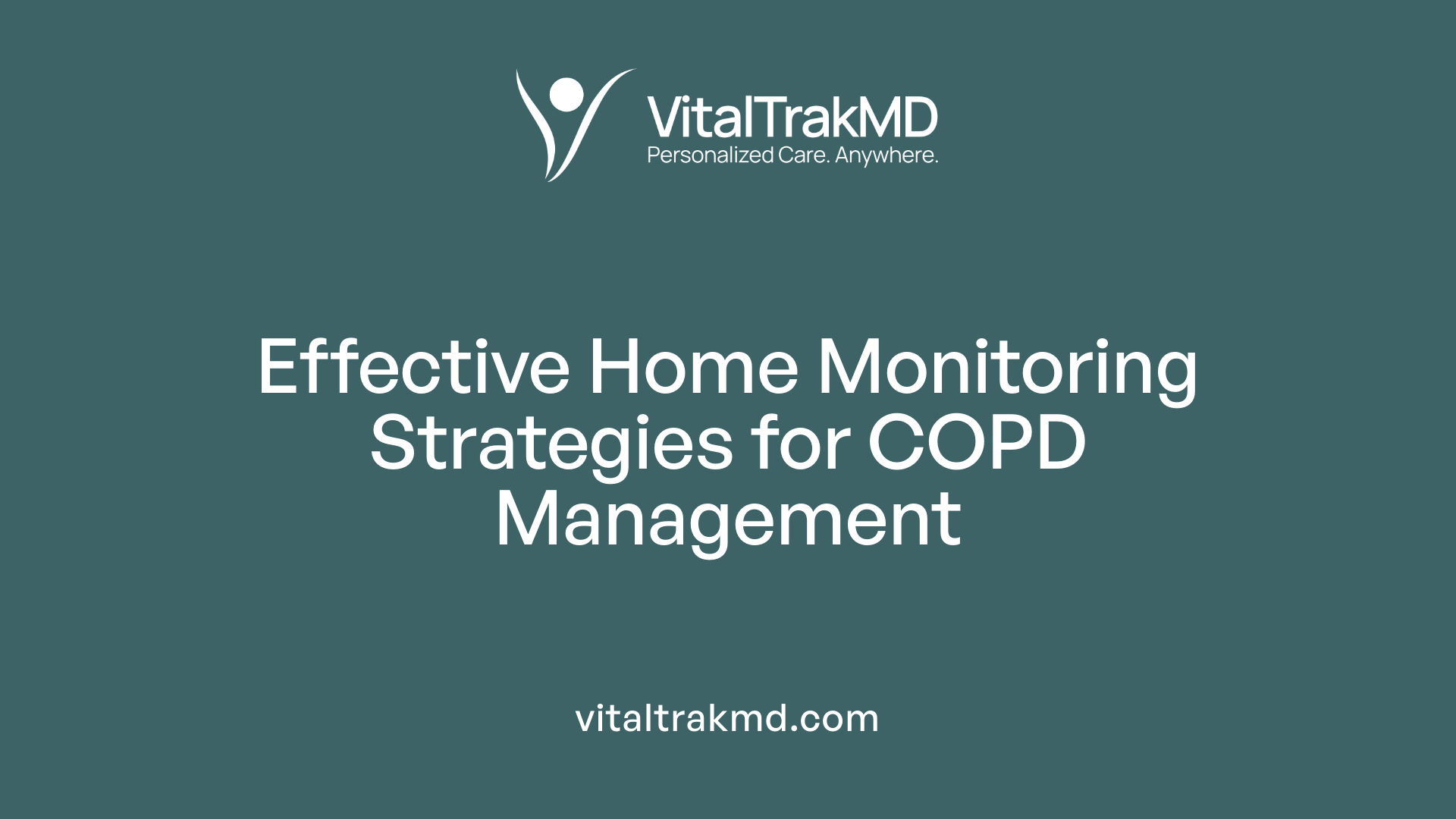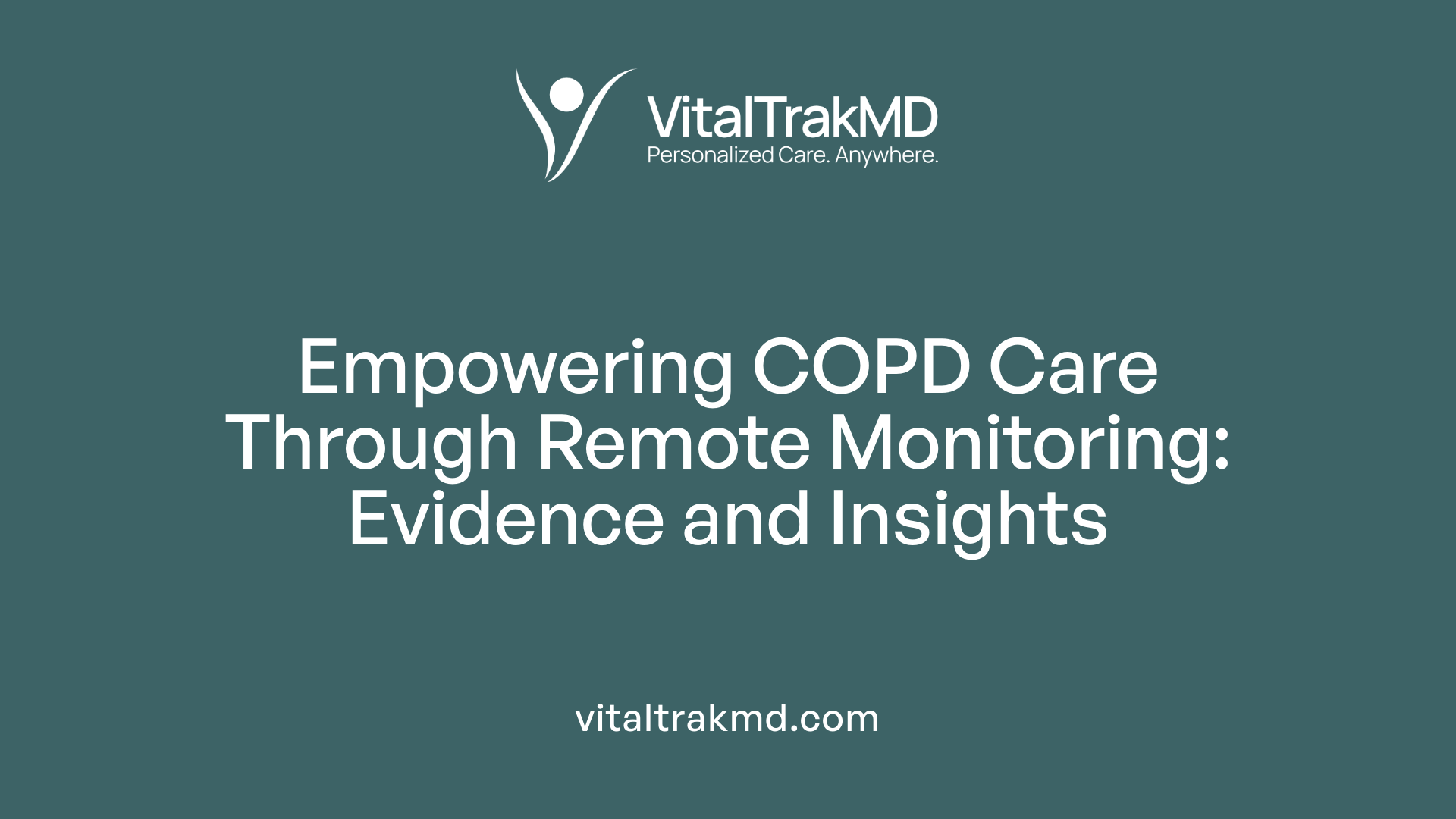Monitoring COPD from Home with Hybrid Care Models

Understanding the Shift to Digital and Remote Healthcare in COPD Management
Chronic Obstructive Pulmonary Disease (COPD) poses ongoing challenges in healthcare delivery, especially given its unpredictable nature and the need for continuous management. Recent advancements in digital health and telemedicine have paved the way for innovative hybrid care models that combine remote monitoring, virtual coaching, and traditional in-person care. This article explores how these digital interventions are transforming COPD management, improving patient outcomes, and reducing healthcare costs.
Monitoring Key Parameters in COPD via Remote Technologies
What are the key parameters to monitor in patients with COPD using remote health technologies?
Remote health technologies offer an effective way to continuously monitor patients with COPD, helping to detect early signs of exacerbation and manage the condition more effectively. Critical parameters include vital signs such as blood oxygen saturation, heart rate, and respiratory rate. These measurements can be obtained non-invasively through wearable sensors, pulse oximeters, and connected devices.
Lung function assessment is another vital aspect, often performed using portable spirometry devices that patients can use at home. These devices transmit real-time spirometry data to healthcare providers, enabling ongoing evaluation of lung capacity and airflow limitation.
Continuous analysis of respiratory sounds through smart devices is increasingly utilized. Smartphone microphones and specialized sensors can detect abnormal lung sounds, such as wheezing and crackles, which could indicate worsening airway obstruction.
In addition to physiological data, patient-reported symptoms are crucial. These include the severity of dyspnea (shortness of breath), cough frequency, chest pain, and other discomforts. Digital platforms integrated with questionnaires like the COPD Assessment Test (CAT) allow patients to regularly report their symptoms, helping clinicians track disease progression and response to treatment.
Environmental factors, such as air quality and allergens, significantly influence COPD exacerbations. Remote monitoring systems often incorporate environmental sensors or access environmental data to assess air pollution levels, which can trigger symptom worsening.
Lifestyle factors like physical activity levels, sleep patterns, and smoking habits provide valuable context for disease management. Devices like activity trackers and sleep monitors help gather this comprehensive data.
Artificial Intelligence (AI) models analyze combined data sets, providing early alerts for potential exacerbations. These models can identify patterns indicating deterioration, allowing preemptive clinical interventions.
Implementing such integrated digital monitoring systems requires attention to safety, data privacy, and user accessibility. Simplifying device interfaces, ensuring cybersecurity, and providing patient training are critical for successful remote COPD management.
By harnessing these parameters through remote technologies, healthcare providers can enhance disease surveillance, optimize treatment plans, and ultimately improve the quality of life for COPD patients.
Self-Management at Home for COPD Patients
How can COPD patients effectively manage their condition at home?
Managing COPD effectively involves multiple strategies that focus on medication adherence, symptom recognition, lifestyle adjustments, and education. Patients should strictly follow their prescribed medication regimens and master proper inhaler techniques to ensure proper delivery of medication.
Developing a personalized action plan with healthcare providers is essential for recognizing early signs of worsening symptoms such as increased shortness of breath, wheezing, or changes in mucus production. This plan guides prompt responses to exacerbations, reducing hospital visits.
Physical activity plays a vital role in maintaining lung health. Engaging in regular, tailored exercises, including breathing techniques like pursed-lip and diaphragmatic breathing, can reduce breathlessness and improve oxygen efficiency.
Maintaining a healthy indoor environment is crucial. Patients should avoid irritants such as smoke, strong odors, and pollutants by using air purifiers, keeping living spaces clean, and ensuring good ventilation. Quitting smoking remains one of the most important steps to slow disease progression.
Preventive measures like vaccinations against influenza and pneumococcal infections reduce the risk of respiratory infections that can worsen COPD. Adequate nutrition and hydration support overall health, while managing stress through relaxation techniques improves quality of life.
Finally, patient education about proper self-management techniques, oxygen safety, and mucus clearance empowers individuals to take an active role in their health. Regular monitoring with digital health tools and ongoing communication with healthcare teams help catch issues early and adjust treatment plans as needed.
Implementing these comprehensive self-management strategies allows COPD patients to lead healthier, more comfortable lives while reducing the risk of severe exacerbations.
Monitoring Strategies and Requirements for COPD at Home

What are the recommended monitoring requirements for COPD patients using remote health methods?
Effective remote management of COPD involves a comprehensive approach to regular assessment and data collection. Patients are advised to measure their oxygen saturation (SpO2) and vital signs, such as heart rate and respiratory rate, frequently. These measurements are typically performed using pulse oximeters and wearable health devices that can transmit data directly to healthcare providers.
Daily lung function testing is also crucial. Home spirometers or peak flow meters enable patients to monitor their lung capacity and airflow, helping to identify early signs of exacerbation or deterioration. Regular symptom questionnaires, such as the COPD Assessment Test (CAT), provide insights into symptom burden and health status, assisting clinicians in adjusting treatment plans.
Advanced digital health tools now incorporate AI-driven data analysis. These platforms can scrutinize physiological data, detect patterns, and flag potential exacerbations or respiratory infections early. This predictive capability enhances timely interventions, reducing hospitalizations.
Moreover, ongoing evaluation of patients’ weight, nutritional status, physical activity levels, and functional capacity—measured by walking tests or daily activity logs—is essential for a holistic understanding of disease progression. These parameters help tailor personalized treatment strategies and monitor overall health.
Ensuring the usability and accessibility of monitoring devices is fundamental. Devices should be easy to operate, comfortable for daily use, and integrate seamlessly with user-friendly digital platforms. This encourages consistent self-monitoring and engagement, ultimately supporting better disease management at home.
Integration of Digital Solutions & Telehealth in COPD Care

How can COPD patients effectively manage their condition at home?
Managing COPD at home has become increasingly feasible thanks to advances in digital health technology. Remote patient monitoring systems enable patients to track vital signs such as oxygen saturation, lung function, and symptoms using home-based devices like spirometers and pulse oximeters. These systems transmit data in real-time to healthcare providers, allowing for timely assessments and early intervention if exacerbations are detected.
Wearable devices, including smartwatches and fitness trackers, offer continuous monitoring of physical activity, heart rate, and sleep patterns. Mobile apps complement these devices by incorporating symptom diaries and biometric logs, empowering patients to participate actively in their care and maintain adherence to treatment plans.
Artificial intelligence (AI) and machine learning algorithms analyze incoming data from wearables and monitoring systems to identify patterns indicative of worsening health. These advanced tools facilitate early diagnosis of exacerbations, enabling preemptive steps that can prevent hospitalizations.
Telerehabilitation and virtual coaching programs provide personalized exercise routines and education about disease management via video consultations and app-based platforms. Digital pulmonary rehabilitation programs include interactive modules that improve exercise capacity and promote self-management.
Real-time data analysis supports early detection of exacerbations by recognizing deviations from a patient’s baseline, alerting both patients and clinicians to potential issues before symptoms worsen substantially.
Enhancing patient engagement and adherence is critical in chronic disease management. Digital health technologies—such as reminders for medication, appointments, and device measurements—improve compliance with treatment and monitoring routines.
Overall, integrating these digital solutions within a hybrid care model enhances the ability of COPD patients to manage their condition effectively at home, reducing the burden on healthcare systems and improving patients’ quality of life.
| Technology | Purpose | Benefits | Additional Notes |
|---|---|---|---|
| Remote Monitoring Devices | Track vital signs and symptoms | Early detection of exacerbations | Includes spirometers, pulse oximeters |
| Wearables & Apps | Continuously monitor activity & biometric data | Enhance self-management | Includes smartwatches, fitness trackers |
| AI & Machine Learning | Analyze data for patterns | Predict exacerbations | Supports personalized care |
| Tele-rehabilitation | Virtual exercise & education | Improve exercise capacity | Remote, interactive modules |
| Real-time Data Analysis | Detect deviations from baseline | Prevent hospitalizations | Alerts clinicians and patients |
| Patient Engagement Tools | Reminders & educational content | Improve adherence | Critical for chronic disease management |
This comprehensive integration of digital health tools is establishing a new standard for managing COPD more effectively outside of traditional clinical settings, as supported by recent research and technological advancements.
Implementing Digital Interventions: Strategies & Best Practices
What strategies and best practices are recommended for implementing digital health interventions for COPD at home?
Effectively implementing digital health interventions for COPD management involves several strategic steps to ensure patient engagement, safety, and optimal health outcomes.
Firstly, comprehensive patient education is essential. Patients must be trained on how to correctly use devices such as portable spirometers, pulse oximeters, and mobile apps. Clear instructions on device operation, symptom tracking, and the importance of consistent monitoring help improve adherence.
Routine symptom and lung function monitoring constitutes the backbone of optimal digital care. Regular use of portable spirometers and wearable sensors provides ongoing data that can detect early signs of exacerbations. This proactive approach allows healthcare providers to intervene before conditions worsen.
Incorporating telehealth consultations and telerehabilitation programs into regular care routines offers continuous support and guidance. Virtual visits enable clinicians to review patient data, adjust treatments, and provide educational reinforcement without the need for in-person visits. Telerehabilitation programs can also improve exercise capacity and functional status.
Artificial Intelligence (AI) tools are increasingly integral in early risk prediction. AI algorithms analyze data collected from devices and digital inputs to identify patterns indicating impending exacerbations or other health risks. Personalized management plans can be tailored based on AI insights, enhancing care precision.
Ensuring the use of user-friendly digital tools is critical. Designing intuitive interfaces and simplifying data entry encourages sustained patient engagement. Additionally, addressing data security and privacy concerns reassures patients that their personal information is protected.
Finally, interventions should be adaptable to various patient populations, including underserved groups. Cultural competence, language options, and affordable technology access are vital considerations to maximize reach and effectiveness.
Evidence suggests that these combined strategies can reduce emergency visits, decrease hospitalizations, and improve overall quality of life for COPD patients. Continuous monitoring, feedback, and iteration of implementation practices help tailor interventions to diverse needs and emerging technologies, ensuring sustained success.
Evidence Supporting Hybrid Care Models for COPD

What evidence supports the effectiveness of hybrid care models in COPD management?
Recent studies underscore the benefits of integrating in-person care with digital health technologies to improve outcomes for COPD patients. One significant area of evidence comes from research demonstrating reductions in hospitalizations, emergency department visits, and readmissions through these hybrid approaches.
For instance, a community-based digital health intervention that included biometric monitoring, symptom tracking, and telehealth support showed lower odds of hospitalization (OR 0.67) and 30-day readmission rates (OR 0.38). Similarly, a 6-month remote monitoring program using home spirometry and pulse oximetry did not significantly alter quality of life but was feasible and safe, indicating that remote tools can complement traditional care.
Biometric data collection, such as continuous oxygen saturation, heart rate, and activity levels, supports early detection of exacerbations, enabling timely interventions. Healthcare workflows integrating these data—like automated alerts and clinical dashboards—prompt clinicians to respond proactively, potentially preventing severe episodes.
The combination of remote monitoring with virtual pulmonary rehabilitation and shared decision-making enhances patient engagement and adherence. For example, telepulmonary rehab programs have shown to improve exercise capacity and reduce symptom burden, while geriatric-focused telehealth programs have increased independence and mobility among older COPD patients.
Furthermore, studies support that combining face-to-face consultations with virtual care provides a balanced approach, ensuring patients receive personalized education, behavioral coaching, and continuous monitoring.
| Research Focus | Outcomes | Technology Used | Additional Notes |
|---|---|---|---|
| Hospitalization and readmission | Reduced odds | Biometric monitoring, telehealth | Supported by digital health support workflows |
| Symptom management | Improved symptom control | Smartphone apps, wearable devices | Enhances patient self-management |
| Adherence and engagement | Increased adherence | Telecoaching, virtual interactions | Geriatric-oriented programs show notable benefits |
| Functional capacity and quality of life | Mixed results | Digital pulmonary rehab | Feasibility demonstrated, efficacy varies |
These collective findings affirm that hybrid models combining in-person visits with remote, technology-enabled care provide a promising pathway to better manage COPD. They reduce health care utilization and empower patients through ongoing self-monitoring and personalized support, demonstrating clear advantages over conventional models.
Community-based Digital & Telehealth Programs in COPD Management
What is the role of community-based digital health and telehealth programs in managing COPD?
Community-based digital health and telehealth initiatives have become essential components in the contemporary management of chronic obstructive pulmonary disease (COPD). These programs significantly enhance access to healthcare services, particularly for patients residing in remote, rural, or underserved areas who might otherwise face barriers to regular clinical visits.
One of the primary advantages of these programs is their focus on supporting self-management. Educating patients about their condition, monitoring symptoms, and adhering to personalized action plans can lead to substantial improvements in health outcomes. Using digital tools such as wearable sensors and smartphone applications, patients can track vital signs, inhaler use, and environmental triggers like air pollution levels in real-time.
Wearable sensors and smart inhalers are instrumental in providing continuous data streams, enabling early detection of exacerbations before they escalate into severe episodes. This proactive approach helps in timely intervention, thereby reducing hospital admissions and emergency visits.
Telehealth services, including virtual consultations, are integral to maintaining ongoing patient engagement. Tele-rehabilitation programs offer home-based exercise regimens, reducing the need for in-person visits and making pulmonary rehabilitation more accessible. During the COVID-19 pandemic, these remote services proved especially vital, ensuring uninterrupted care while minimizing infection risk.
Furthermore, seamless communication channels through telehealth platforms foster continuity of care. Patients remain connected with healthcare providers, receive medication management support, and clarify concerns without leaving their homes. This ongoing engagement improves treatment adherence, patient satisfaction, and overall quality of life.
In summary, community-based digital and telehealth programs empower patients, optimize disease management, and address disparities in healthcare access. By combining real-time monitoring, personalized interventions, and remote healthcare delivery, these programs are transforming COPD care and reducing the burden on healthcare systems.
Future Directions in Hybrid Healthcare for Respiratory Diseases

What innovations and future directions are emerging in hybrid healthcare models for respiratory disease management?
The landscape of respiratory disease management is set to evolve significantly with technological advancements and systemic reforms. One promising development is the integration of artificial intelligence (AI) and machine learning (ML) to enhance early detection of exacerbations, tailor treatment plans, and leverage predictive analytics. These tools can analyze vast amounts of patient data, including biometric measurements and environmental factors, to support proactive interventions.
Combining environmental sensors with biometric data is another emerging trend. These sensors measure air quality, allergens, and pollutants, providing context-aware insights when paired with individual health metrics. This integrated approach helps identify exposure risks and supports timely, preemptive care strategies.
The expansion of mobile health solutions and wearable technologies continues to empower patients in self-managing their conditions. Smartphone-based applications, smart inhalers, and wearable sensors enable continuous monitoring of symptoms, vital signs, and physical activity. Such tools foster early reporting of issues and enhance patient engagement.
To fully realize the benefits of these innovations, healthcare systems need to adapt policies and reimbursement frameworks. Clinicians require streamlined workflows that integrate new technologies into routine care without adding excess burden. Policymakers and healthcare providers must collaborate to create supportive regulations and incentives that drive adoption.
Despite these advancements, several research gaps persist. Future studies should focus on optimizing AI algorithms for diverse populations, evaluating long-term outcomes, and ensuring equitable access to digital health services. Innovations should also address usability challenges to maximize adherence and effectiveness.
In summary, the future of hybrid respiratory care lies in harnessing AI, environmental analytics, personalized digital tools, and system-wide policy changes to improve disease management, reduce hospitalizations, and enhance patient quality of life. Continual research and innovation are crucial to overcoming current limitations and expanding the reach of digital respiratory health solutions.
| Innovation Area | Technology/Approach | Expected Impact |
|---|---|---|
| AI & Machine Learning | Predictive analytics, early detection | Proactive interventions, personalized care |
| Environmental Sensors | Air quality, allergen monitoring | Exposure management, preemptive action |
| Digital & Mobile Tools | Apps, wearables, smart devices | Continuous monitoring, patient engagement |
| System & Policy | Reimbursement, clinical workflows | Seamless integration into healthcare systems |
| Research & Development | Usability, equity, efficacy | Improved adoption and health outcomes |
Exploring these fields will shape a future where respiratory diseases are managed more effectively through tailored, technology-driven, and system-supported strategies.
Clinical Outcomes and Research Findings on Digital Hospital and Remote Monitoring

What evidence supports the effectiveness of hybrid care models in COPD management?
Recent studies underscore the potential of hybrid care models—those that combine telehealth, remote monitoring, and in-person care—in managing COPD effectively. Evidence shows that these approaches can improve adherence to treatment, better control symptoms, and reduce hospitalizations.
For instance, interventions that incorporate biometric data collection, symptom tracking, and telehealth consultations have been associated with fewer hospital admissions. A community-based digital health program utilizing biometric monitoring, symptom logs, and on-demand services saw a reduction in 30-day readmissions, with odds dropping to 0.38 compared to controls. Similarly, pulmonary rehabilitation programs that blend digital tools with personalized coaching have significantly improved patients' exercise capacity and symptom control.
High adherence rates, such as over 95% in some remote monitoring studies, demonstrate that patients are receptive to these models. For example, a 26-week remote monitoring trial with COPD patients showed that most participants completed regular surveys and maintained device use, leading to improved symptom scores.
Older adults participating in telephonic coaching programs experienced better mobility and independence, highlighting that personalized remote approaches can enhance quality of life across age groups.
Overall, this research supports that integrated digital and traditional care strategies can optimize health outcomes and decrease healthcare costs by reducing unnecessary hospital stays and emergency visits.
Effects on quality of life, symptom burden, and lung function
Although some interventions did not significantly improve health-related quality of life (HrQoL) directly, many studies recorded notable improvements in symptom burden and functional capacity. For example, patients using remote pulmonary rehabilitation reported a significant 2.48-point reduction in symptom severity scores. Remote spirometry and pulse oximetry performed at home effectively tracked lung function, although some studies noted that these tools did not always lead to measurable changes in lung metrics. Still, continuous symptom monitoring facilitated earlier intervention during exacerbations.
The use of environmental sensors and wearable devices enriched understanding of how external factors influence COPD symptoms, leading to targeted management strategies.
Impact on hospitalization, readmissions, and emergency visits
Implementing remote monitoring and hybrid care models has shown promising results in decreasing acute care use. In several recent studies, including those conducted across the UK and US, intervention groups had lower odds of hospitalization (OR 0.67) and 30-day readmissions (OR 0.38). Trends suggest reduced ED visits and shorter hospital stays, although not always reaching statistical significance.
For instance, a 6-month community-based digital health intervention showed a trend toward fewer hospitalizations, aligning with the goal of minimizing high-cost acute episodes. The ability to detect early signs of exacerbation through telemonitoring allows timely intervention, often preventing escalation to emergency care.
Patient adherence and satisfaction with remote systems
Acceptance and usability are critical for the success of digital health systems. Many studies report high adherence rates, frequently exceeding 80-90%. Patients generally find remote monitoring tools, such as wearable devices and smartphone apps, acceptable and easy to integrate into daily routines. For example, participants in a remote COPD monitoring trial wore smartwatches for nearly 19 hours daily, with survey completion rates below 93%, indicating strong engagement.
Feedback from users typically highlights the convenience, increased awareness of their condition, and the reassurance provided by continuous monitoring. Some minor usability issues are reported, but with appropriate training and user-friendly designs, these barriers can be minimized.
Research evidence from recent studies demonstrating clinical benefits
Emerging research paints a positive picture of digital interventions in COPD care. A study from Zurich utilizing a 12-week hybrid virtual coaching program showed that although primary outcomes like quality of life did not significantly improve, notable gains in physical activity (an increase of over 2,100 steps daily) and symptom relief were observed. Another trial integrating biometric data collection, symptom tracking, and on-demand services observed reduced hospitalization odds by approximately 33%, with significant reductions in 30-day readmissions.
In the US, a 26-week remote patient monitoring study demonstrated high adherence and improved symptom scores, supporting the feasibility and benefits of these approaches. Collectively, these findings advocate for broader adoption of digital and hybrid models in COPD management, aligning clinical outcomes with patient-centered care.
| Study/Program | Duration | Main Components | Outcomes | Notable Findings |
|---|---|---|---|---|
| Zurich Hybrid Coaching | 12 weeks | Education, physical activity, virtual physician | No significant HRQoL change | Increased physical activity (~2147 steps/day) |
| Community Digital Intervention | 6 months | Biometric monitoring, symptom tracking, tele-rehab | Lower hospitalizations | Reduced 30-day readmission odds to 0.38 |
| US RPM Pilot | 26 weeks | Wearable sensors, case management | Symptom reduction, high adherence | Improved COPD symptom scores |
As research expands, the integration of digital health tools continues to demonstrate promise in improving both clinical and quality of life outcomes for patients with COPD.
The Future of Home-Based COPD Management
As digital health innovations continue to evolve, the integration of remote monitoring and hybrid care models will become central to managing COPD effectively. Evidence indicates these approaches can reduce hospitalizations, improve quality of life, and promote patient engagement. Ongoing research, technological advancements, and policy support will further enhance the capacity for personalized, accessible, and efficient COPD care at home, ultimately transforming patient outcomes and the healthcare landscape.
References
- Hybrid Virtual Coaching and Telemonitoring in COPD Management
- A Hybrid Model to Classify Patients with Chronic Obstructive ...
- Evaluation of an integrated digital and mobile intervention to ...
- Evaluation of an Integrated Digital and Mobile Intervention for COPD ...
- COPD Foundation – Home Monitoring in COPD - Nonin
- The Power of Digital Health & Analytics for Asthma, COPD, and ILD
- Remote monitoring of patients with COPD disease using a tablet ...
Recent articles
Want to Feel Better and Live Healthier?
Join hundreds of patients taking control of their health with personalized care that fits their life – not the other way around.
Rated 4.8/5 by 32+ customers







